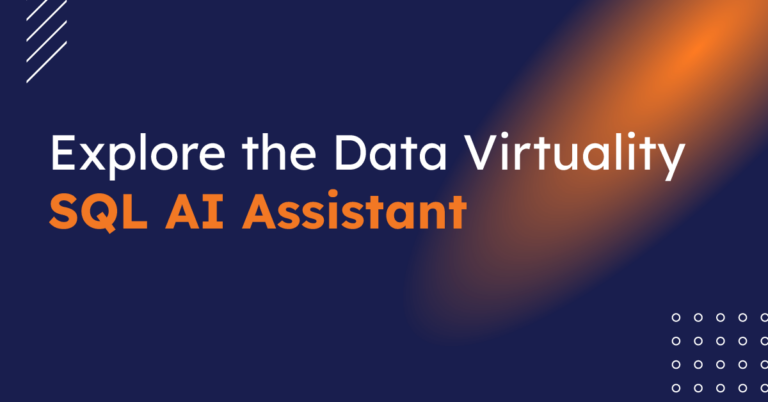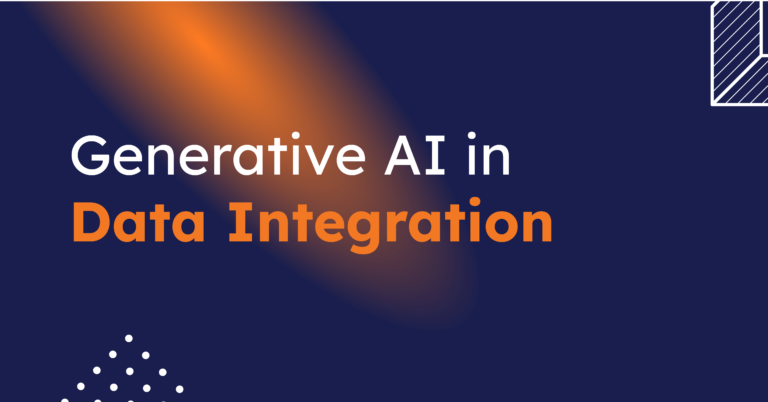
CData Software Acquires Data Virtuality to Modernize Data Virtualization for the Enterprise
Data Virtuality brings enterprise data virtualization capabilities to CData, delivering highly-performant access to live data at any scale.
Explore how you can use the Data Virtuality Platform in different scenarios.
Learn more about the Data Virtuality Platform or to make your work with Data Virtuality even more successful.
Insights on product updates, useful guides and further informative articles.
Find insightful webinars, whitepapers and ebooks in our resource library.
Stronger together. Learn more about our partner programs.
Read, watch and learn what our customers achieved with Data Virtuality.
In our documentation you will find everything to know about our products
Read the answers to frequently asked questions about Data Virtuality.
In this on-demand webinar, we look at how a modern data architecture can help data scientists to be faster and to work more efficiently.
Learn more about us as a company, our strong partner ecosystem and our career opportunities.
How we achieve data security and transparency
Want to know how to use PostgreSQL’ s great functionality to work with JSON objects? Read on! Originally introduced in version 9.2, this feature was greatly enhanced in version 9.3 and we will look at the operators that come with the JSON datatype. We assume that you have an installed version of PostgreSQL 9.3 or higher if you want to work through the examples shown in this post.
The main aspect of the JSON support is the new datatype and its supplementary functions and operators. In this post, we focus on the operators since they form a strong pillar for typical work with JSON objects. Here is a concise list of the most important new features:
The full list of JSON specific functions can be found at:
https://www.postgresql.org/docs/9.3/static/functions-json.html
Let’s get a quick overview concerning the main usage and differences among the three operators. After that we will show you their usage in several examples.
The operators -> and ->> are easy to use and allow you to point to a specific child element within a JSON object. Both operators can be used either by using the name of the element that is of interest, or by using an index when the current object is an array of elements. It is also possible to provide a dynamic path within a JSON object that we want to specify. For this purpose, the operators #> and #>> have been added and we can say, in terms of the resulting datatype, #> equals -> and #>> equals ->>.
Before we get to the examples, here is a list of the major aspects of the operators:
Operator ->
Operator ->>
Operator #>
Operator #>>
Sometimes I see ::json and sometimes not, what is the difference?
This is an easy one. The operators ->, ->>, #> and #>> require the input datatype json. If PostgreSQL can implicitly convert the parameter to json then you can omit ::json. If you cannot guarantee that the casting is always performed in your statement, you pass ::json and the operators can be used. When in doubt, use the ::json prefix before the first json operator. The following operators, if you are chaining them, neither require nor support this syntax.
Your organization, your deployment choice.
A fully managed hardware and software stack management so you can fully focus on using the data
The Data Virtuality Platform marries two distinct technologies to create an entirely new manner of integrating data
First of all, we need some data which we can use for the exploring purpose. We will use weather data provided by the API at OpenWeatherMap. It may not be the best data in terms of a sophisticated use case but it will be more than enough to get to grips with the operators because the data contains some basic complexity.
Our interest lies in the data four five of the better known English cities London (THE London), Sheffield (Snooker world championship), Liverpool (the Beatles and Mersey Beat Generation), Manchester (this is for the football fans) and Leicester (the delicious Red Leicester cheese). Below is the link to get an API key weather account, which is necessary to get access to weather API:
https://home.openweathermap.org/users/sign_up
If you want to use the same data as in this article, you can execute the following sql statements. Please create a database for testing purposes first. The post assumes that this has already been done. An alternative way is presented after the statements in one statement that creates the new table and fills it with data in one step.
CREATE TABLE public.json_table (myjson json);
INSERT INTO public.json_table VALUES('{"coord":{"lon":-0.13,"lat":51.51},"sys": {"type":3,"id":98614,"message":0.0218,"country":"GB","sunrise":1427693969,"sunset":1427740219},"weather": [{"id":803,"main":"Clouds","description":"broken clouds","icon":"04d"}],"main": {"temp":6.99,"humidity":57,"pressure":1014.9,"temp_min":5.56,"temp_max":10.3},"wind": {"speed":0.7,"gust":1.7,"deg":315},"rain":{"3h":0},"clouds": {"all":64},"dt":1427699997,"id":2643743,"name":"London"}');
INSERT INTO public.json_table VALUES('{"coord":{"lon":-1.47,"lat":53.38},"sys":{"type":3,"id":38764,"message":0.0121,"country":"GB","sunrise":1427694192,"sunset":1427740640},"weather":[{"id":802,"main":"Clouds","description":"scattered clouds","icon":"03d"}],"main":{"temp":4.64,"humidity":75,"pressure":988,"temp_min":4.44,"temp_max":5},"wind":{"speed":3.08,"gust":7.71,"deg":226},"rain":{"3h":0.03},"clouds":{"all":36},"dt":1427699954,"id":2638077,"name":"Sheffield"}');
INSERT INTO public.json_table VALUES('{"coord":{"lon":-2.98,"lat":53.41},"sys":{"type":3,"id":10567,"message":0.0519,"country":"GB","sunrise":1427694552,"sunset":1427741005},"weather":[{"id":800,"main":"Clear","description":"Sky is Clear","icon":"01d"}],"main":{"temp":8,"humidity":67,"pressure":1000,"temp_min":3.33,"temp_max":17.78},"wind":{"speed":4.63,"gust":7.2,"deg":282},"rain":{"3h":0},"clouds":{"all":0},"dt":1427700074,"id":2644210,"name":"Liverpool"}');
INSERT INTO public.json_table VALUES('{"coord":{"lon":-2.24,"lat":53.48},"sys":{"type":3,"id":28022,"message":0.0377,"country":"GB","sunrise":1427694371,"sunset":1427740831},"weather":[{"id":801,"main":"Clouds","description":"few clouds","icon":"02d"}],"main":{"temp":4.66,"pressure":1004,"temp_min":3.33,"temp_max":6.11,"humidity":89},"wind":{"speed":3.6,"gust":5.65,"deg":268},"rain":{"3h":0.0099999999999998},"clouds":{"all":24},"dt":1427700074,"id":2643123,"name":"Manchester"}');
INSERT INTO public.json_table VALUES('{"coord":{"lon":-1.13,"lat":52.64},"sys":{"type":3,"id":184635,"message":0.9267,"country":"GB","sunrise":1427694152,"sunset":1427740519},"weather":[{"id":802,"main":"Clouds","description":"scattered clouds","icon":"03d"}],"main":{"temp":4.92,"humidity":75,"pressure":1013,"temp_min":4.4,"temp_max":5.4},"wind":{"speed":2.9,"gust":7.5,"deg":337},"rain":{"3h":0.024999999999999},"clouds":{"all":36},"dt":1427700055,"id":2644668,"name":"Leicester"}');
Get your personal data from this URL after your created an API key weather account and copy the resulting json into an SQL Editor from pgAdmin. You can insert the full json and make use of the json_array_elements function.
SELECT value as myjson INTO public.json_table
FROM json_array_elements('{"cnt":5,"list":[…]}'::json->'list');
The statement takes the JSON object and extracts the list element from it. As it contains an array with each index holding information regarding one of the selected cities, we can use the predefined function json_array_elements that returns one row for each of the array elements. Due to SELECT INTO, all returned rows are inserted into the new table public.json_table.
Examples in the SELECT Clause Now the time has come to finally look at some examples. We hop right into it.
Example SELECT
SELECT myjson::json->'name' as CityName
FROM public.json_table;

The query takes the object and searches for the element name. This element’s value is returned for each row in the table. Note that in the example the casting of the column to datatype json is performed.
Example SELECT with returned ‘sub’ json
SELECT myjson::json->'name' as CityName, myjson::json->'coord' as Coordinates
FROM public.json_table;

We are getting slightly more complex by selecting two elements, both referenced via -> operator and their name, from the table. Note that the second column from the output is itself a JSON object which we will be targeting in the next example.
Example SELECT with the ‘sub’ json strings
SELECT myjson::json->'name' as CityName, myjson::json->'coord'->'lon' as Longitude,myjson::json->'coord'->'lat' as Latitude
FROM public.json_table;

The example above shows the ‘chaining’ of the -> operator. The first usage has the ::json prefix to ensure that the text is being handled as json type and the consecutive use of -> allows to reference an element that is within a JSON object which itself exists within a super object. It should be noted that the second use of -> has no preceding ::json.
Example SELECT which returns array
At next, we will reference a specific array element within an object. Looking at an extract from the entry for London, we have {…"weather":[{"id":803,"main":"Clouds","description":"broken clouds","icon":"04d"}],…}. Clearly, the element weather contains an array, even if only of length 1. If we want to get further into this array, we need to specify that we are interested in the array element at index 0 (indexes start with 0, not 1).
SELECT myjson::json->'name' as CityName, myjson::json->'weather'->0 as DetailedWeather
FROM public.json_table;

Clearly, we only care about the core weather information and decide to select the elements main and description from the JSON object that is held in array element at index 0.
Example which addresses elements within this array
SELECT myjson::json->'name' as CityName, myjson::json->'weather'->0->'main' as WeatherShort, myjson::json->'weather'->0->'description' as WeatherLong
FROM public.json_table;

Above example also shows how the combination of element names or indexes can be used to navigate to every part of a JSON object. Speaking of, or rather writing about, paths, we can also use the #> operator to achieve the same goal. Only that the syntax is slightly different.
Example SELECT with specific element referenced by the #> operator
SELECT myjson::json#>'{name}' as CityName,myjson::json#>'{weather,0,main}' as WeatherShort, myjson::json#>'{weather,0,description}' as WeatherLong
FROM public.json_table;
No difference is in the result but some might prefer this way to point to distinct elements. In each path description (delimited by { and }), integer values are considered as index numbers and strings as element names; like -> and ->>.
In all these example the last occurrence of -> could have been swapped easily with ->> and no error would occur. To fully understand their difference, we will try to filter data in the next two examples.
WHERE clauses with JSON
At best we repeat a part of the statement from above regarding the -> operator: “Return type is json and the result cannot be used with functions and operators that require a string-based data type”. So we might be interested in all cities that have cloudy weather. We might try something like the following:
Wrong
SELECT myjson::json->'name' as CityName
FROM public.json_table
WHERE myjson::json->'weather'->0->'main' = 'Clouds';
An error is thrown by PostgreSQL and reads: Error message:
ERROR: Operator does not: json = unknown LINE 3: WHERE myjson::json->'weather'->0->'main' = 'Clouds';
This tells us that the result of myjson::json->’weather’->0->’main’ is of type json but the = operator does not support json. If we replace the last -> by ->> then the result is not an JSON object but a simple text that supports =. Now it should be clear when to use an operator that returns json and when to use one that returns text. The same applies to #> and #>>, if we want to re-use the returned result.
Correct
SELECT myjson::json->'name' as CityName
FROM public.json_table
WHERE myjson::json->'weather'->0->>'main' = 'Clouds';

Use ->> instead of -> when the returned values shall be re-used with ordinary operators and functions!
Another, slightly more complex WHERE
SELECT myjson::json->'name' as CityName, myjson::json->'main'->>'temp' as Temperature
FROM public.json_table
WHERE myjson::json->'weather'->0->>'main' = 'Clouds' AND CAST(myjson::json->'main'->>'temp' as float) > 5;
Our second example with WHERE clauses cares about all cities that have cloudy weather but more than 5°Centigrade. As the API link above contained the part ‘&units=metric’, the temperatures are provided in °C. Here is the result from the query:

We will have a final example showing the use of our json operators within a GROUP BY clause. GROUP BY with JSON operators
GROUP BY needs the ->> or the #>> operator in the last place of the chain order to being capable of grouping. The following example groups by type of weather and returns the number of cities, respectively.
SELECT myjson::json->'weather'->0->>'main' as WeatherType, COUNT(*) as AffectedCities
FROM public.json_table
GROUP BY myjson::json->'weather'->0->>'main'

The counterpart with #>> is
SELECT myjson::json#>>'{weather,0,main}' as WeatherType, COUNT(*) as AffectedCities
FROM public.json_table
GROUP BY myjson::json#>>'{weather,0,main}'
Unfortunately, all good things come to an end, and so does this blog post. We hope that you’re now well-equipped to use the basic operators to navigate through JSON objects in order to select or reference any particular element. PostgreSQL also provides a good deal of functions to increase the capabilities of working with and building JSON type objects even further. However, the most common usage scenarios when data is already available were covered in this article and the examples have shown the differences and usages of the operators. We encourage all our readers to try to make the most of the functionalities that come with PostgreSQL.
If you’re interested in learning more check out our blogpost on querying MongoDB Databases with standard SQL statements using Data Virtuality.
Book a demo and learn how you can enable Data Mesh with the Data Virtuality Platform:

Data Virtuality brings enterprise data virtualization capabilities to CData, delivering highly-performant access to live data at any scale.

Discover how integrating data warehouse automation with data virtualization can lead to better managed and optimized data workflows.

Discover how our ChatGPT powered SQL AI Assistant can help Data Virtuality users boost their performance when working with data.

While caching offers certain advantages, it’s not a one-size-fits-all solution. To comprehensively meet business requirements, combining data virtualization with replication is key.

Explore the potential of Data Virtuality’s connector for Databricks, enhancing your data lakehouse experience with flexible integration.

Generative AI is an exciting new technology which is helping to democratise and accelerate data management tasks including data engineering.
Leipzig
Katharinenstrasse 15 | 04109 | Germany
Munich
Trimburgstraße 2 | 81249 | Germany
San Francisco
2261 Market Street #4788 | CA 94114 | USA
Follow Us on Social Media
Our mission is to enable businesses to leverage the full potential of their data by providing a single source of truth platform to connect and manage all data.